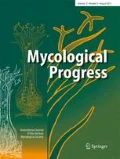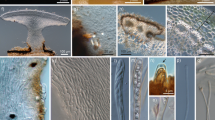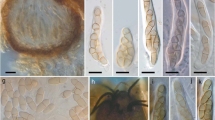Abstract
Hymenoscyphus fraxineus is an invasive fungal pathogen that causes ash dieback in Europe. Recent investigations have identified H. fraxineus on herbarium specimens in Korea. In this paper, these specimens, plus five additional collections, were studied by internal transcribed spacer (ITS) screening and subsequent phylogenetic analysis using three additional sequence markers (actin, calmodulin, EF1-α). Using the concept of genealogical concordance phylogenetic species recognition (GCPSR), H. fraxineus was confirmed in five of the collections on petioles of Fraxinus mandshurica and F. chinensis subsp. rhynchophylla. The remaining collections revealed two novel species, both occurring on petioles of F. chinensis subsp. rhynchophylla. They are described as Hymenoscyphus occultus sp. nov. and Hymenoscyphus koreanus sp. nov., based on morphological and molecular data. Both develop a Chalara-like anamorph similar to that of H. fraxineus. Together with the newly described H. albidoides from China and H. linearis from Japan, the clade containing H. fraxineus now consists of six species. Within this clade, H. koreanus forms a sister species to H. albidus and both share highly similar morphological and molecular features. Hymenoscyphus occultus is more distantly related to H. fraxineus and shows proximity to H. linearis. Ascocarp production on ash leaf malt-extract agar could be shown for the two new species, and for H. linearis and H. albidus. The experiment demonstrated these species’ ability to self-fertilize. Our findings suggest the diversity of Hymenoscyphus species on Fraxinus sp. might be higher than currently known, calling for further investigations on petioles of other Fraxinus species.




Similar content being viewed by others
References
Baral H-O, Queloz V, Hosoya T (2014) Hymenoscyphus fraxineus, the correct scientific name for the fungus causing ash dieback in europe. IMA Fungus 5(1):79–80. doi:10.5598/imafungus.2014.05.01.09
Baral HO (1987) Der Apikalapparat der Helotiales - Eine lichtmikroskopische Studie über Arten mit Amyloidring. Zeitschrift für Mykologie 53(1):119–135
Baral HO (1996) Hymenoscyphus seminis-alni, a new species of the H. fructigenus-complex. Mycotaxon 60:249–256
Baral HO, Bemmann M (2014) Hymenoscyphus fraxineus vs. Hymenoscyphus albidus - A comparative light microscopic study on the causal agent of European ash dieback and related foliicolous, stroma-forming species. Mycology 5(4):228–290. doi:10.1080/21501203.2014.963720
Barnes I, Crous PW, Wingfield BD, Wingfield MJ (2004) Multigene phylogenies reveal that red band needle blight of Pinus is caused by two distinct species of Dothistroma, D. septosporum and D. pini. Stud Mycol 50:551–565
Carbone I, Kohn LM (1999) A method for designing primer sets for speciation studies in filamentous ascomycetes. Mycologia 91(3):553–556. doi:10.2307/3761358
Dlugosch KM, Parker IM (2008) Founding events in species invasions: genetic variation, adaptive evolution, and the role of multiple introductions. Mol Ecol 17(1):431–449. doi:10.1111/j.1365-294X.2007.03538.x
Drummond A, Rambaut A (2008) Tracer [Online]. Available at: http://beast.bio.ed.ac.uk/Tracer. Accessed 25 October 2013
Gross A, Holdenrieder O (2013) On the longevity of Hymenoscyphus pseudoalbidus in petioles of Fraxinus excelsior. Forest Pathol 43(2):168–170. doi:10.1111/efp.12022
Gross A, Holdenrieder O, Pautasso M, Queloz V, Sieber TN (2014a) Hymenoscyphus pseudoalbidus, the causal agent of ash dieback. Mol Plant Pathol 15(1):109–117
Gross A, Hosoya T, Queloz V (2014b) Population structure of the invasive forest pathogen Hymenoscyphus pseudoalbidus. Mol Ecol 23(12):2943–2960. doi:10.1111/mec.12792
Gross A, Hosoya T, Zhao j, Baral HO (2014, accepted article) Hymenoscyphus linearis sp. nov. – Another close relative of the ash dieback pathogen H. fraxineus. Mycol Progr
Gross A, Zaffarano PL, Duo A, Grünig CR (2012) Reproductive mode and life cycle of the ash dieback pathogen Hymenoscyphus pseudoalbidus. Fungal Genet Biol 49(12):977–986. doi:10.1016/j.fgb.2012.08.008
Grünig CR, Linde CC, Sieber TN, Rogers SO (2003) Development of single-copy RFLP markers for population genetic studies of Phialocephala fortinii and closely related taxa. Mycol Res 107(11):1332–1341
Grünig CR, McDonald BA, Sieber TN, Rogers SO, Holdenrieder O (2004) Evidence for subdivision of the root-endophyte Phialocephala fortinii into cryptic species and recombination within species. Fungal Genet Biol 41(7):676–687
Han J-G, Shrestha B, Hosoya T, Lee H-K, Sung G-H, Shin H-D (2014) First report of the ash dieback pathogen Hymenoscyphus fraxineus in Korea. Microbiology 42(4):391–396
Hosoya T, Otani Y, Furuya K (1993) Materials for the fungus flora of Japan (46). T Mycol Soc Jpn 34(4):429–432
Husson C, Scala B, Cael O, Frey P, Feau N, Ioos R, Marcais B (2011) Chalara fraxinea is an invasive pathogen in France. Eur J Plant Pathol 130(3):311–324. doi:10.1007/s10658-011-9755-9
Kirisits T, Dämpfle L, Kräutler K (2013) Hymenoscyphus albidus is not associated with an anamorphic stage and displays slower growth than Hymenoscyphus pseudoalbidus on agar media. Forest Pathol 43(5):386–389. doi:10.1111/efp.12042
Kowalski T (2006) Chalara fraxinea sp. nov. associated with dieback of ash (Fraxinus excelsior) in Poland. Forest Pathol 36(4):264–270
Lanfear R, Calcott B, Ho SYW, Guindon S (2012) PartitionFinder: combined selection of partitioning schemes and substitution models for phylogenetic analyses. Mol Biol Evol 29(6):1695–1701. doi:10.1093/molbev/mss020
Leach CM (1971) A practical guide to the effects of visible and ultraviolet light on fungi. In: Booth C (ed) Methods in microbiology, vol Volume 4. Academic, New York, pp 609–664. doi:10.1016/s0580-9517(09)70028-5
Marčiulynienė D, Cleary MR, Shabunin D, Stenlid J, Vasaitis R Detection of Hymenoscyphus pseudoalbidus in Primorye region, far east Russia; COST Action FP1103 Fraxback 4th MC meeting & workshop "Frontiers in ash dieback research”, 4-6th of September 2013, Malmö, Sweden; accessed online 21.01.2014 http://www.fraxback.eu/. 2013. p 42
McKinney LV, Thomsen IM, Kjær ED, Bengtsson SBK, Nielsen LR (2012) Rapid invasion by an aggressive pathogenic fungus (Hymenoscyphus pseudoalbidus) replaces a native decomposer (Hymenoscyphus albidus): a case of local cryptic extinction? Fungal Ecol 5(6):663–669. doi:10.1016/j.funeco.2012.05.004
Olson Å, Stenlid J (2002) Pathogenic fungal species hybrids infecting plants. Microb Infect 4(13):1353–1359
Oono R, Lutzoni F, Arnold AE, Kaye L, U’Ren JM, May G, Carbone I (2014) Genetic variation in horizontally transmitted fungal endophytes of pine needles reveals population structure in cryptic species. Am J Bot 101(8):1362–1374. doi:10.3732/ajb.1400141
Queloz V, Grünig CR, Berndt R, Kowalski T, Sieber TN, Holdenrieder O (2011) Cryptic speciation in Hymenoscyphus albidus. Forest Pathol 41(2):133–142. doi:10.1111/j.1439-0329.2010.00645.x
Ronquist F, Teslenko M, van der Mark P, Ayres DL, Darling A, Höhna S, Larget B, Liu L, Suchard MA, Huelsenbeck JP (2012) MrBayes 3.2: efficient Bayesian phylogenetic inference and model choice across a large model space. Syst Biol 61(3):539–542. doi:10.1093/sysbio/sys029
Stamatakis A (2006) RAxML-VI-HPC: maximum likelihood-based phylogenetic analyses with thousands of taxa and mixed models. Bioinformatics 22(21):2688–2690. doi:10.1093/bioinformatics/btl446
Stergiopoulos I, Gordon TR (2014) Cryptic fungal infections: the hidden agenda of plant pathogens. Front Plant Sci 5:1–4
Taylor JW, Jacobson DJ, Kroken S, Kasuga T, Geiser DM, Hibbett DS, Fisher MC (2000) Phylogenetic species recognition and species concepts in fungi. Fungal Genet Biol 31(1):21–32. doi:10.1006/fgbi.2000.1228
Taylor JW, Turner E, Townsend JP, Dettman JR, Jacobson D (2006) Eukaryotic microbes, species recognition and the geographic limits of species: examples from the kingdom Fungi. Philos T Roy Soc B 361(1475):1947–1963. doi:10.1098/rstb.2006.1923
Wallander E (2008) Systematics of Fraxinus (Oleaceae) and evolution of dioecy. Plant Syst Evol 273(1):25–49. doi:10.1007/s00606-008-0005-3
White TJ, Bruns T, Lee S, Taylor J (1990) Amplification and direct sequencing of fungal ribosomal RNA genes for phylogenetics. In: Innis MA et al (eds) PCR protocols: A guide to methods and applications. Academic Press, Inc, San Diego and London, pp 315–322
Zhao Y-J, Hosoya T, Baral H-O, Hosaka K, Kakishima M (2012) Hymenoscyphus pseudoalbidus, the correct name for Lambertella albida reported from Japan. Mycotaxon 122:25–41. doi:10.5248/122.25
Zheng H-D, Zhuang W-Y (2013) Hymenoscyphus albidoides sp. nov. and H. pseudoalbidus from China. Mycol Progr 13(3):625–638. doi:10.1007/s11557-013-0945-z
Acknowledgments
We would like to thank O. Holdenrieder, T. Hosoya and V. Queloz for helpful discussions and suggestions; M. Berchtold, A. Duo and S. Stroheker for excellent technical assistance; H.O. Baral and an anonymous reviewer for constructive comments on a previous manuscript draft and C. Syrad for manuscript proofreading. We further acknowledge the Genetic Diversity Center of ETH Zurich for providing laboratory facilities. This study was supported by a grant from ETH Zurich (ETH-04 10–1).
Conflict of interest
The authors declare that they have no conflict of interest.
Author information
Authors and Affiliations
Corresponding author
Electronic supplementary material
Below is the link to the electronic supplementary material.
Online Resource 1
Multiple sequence alignment of the ITS 1 and 2 rDNA region incorporating all samples but H. fructigenus strain CBS_650.92, used to identify unique molecular characters of the two new species H. koreanus and H. occultus. (JPEG 1221 kb)
Online Resource 2
Multiple sequence alignment of the calmodulin gene incorporating all samples but H. fructigenus strain CBS_650.92, used to identify unique molecular characteristics of the two new species H. koreanus and H. occultus. (JPEG 1004 kb)
Rights and permissions
About this article
Cite this article
Gross, A., Han, J.G. Hymenoscyphus fraxineus and two new Hymenoscyphus species identified in Korea. Mycol Progress 14, 19 (2015). https://doi.org/10.1007/s11557-015-1035-1
Received:
Revised:
Accepted:
Published:
DOI: https://doi.org/10.1007/s11557-015-1035-1




